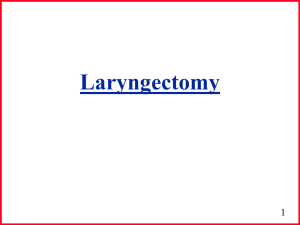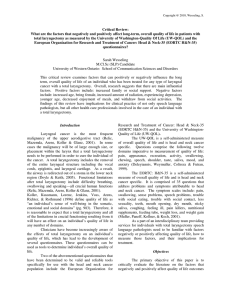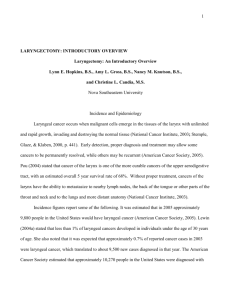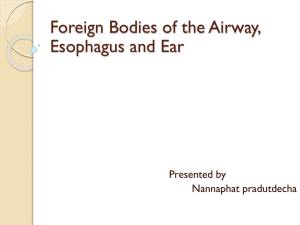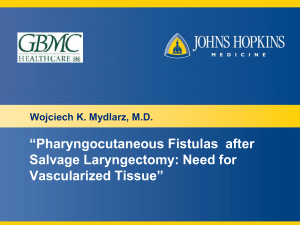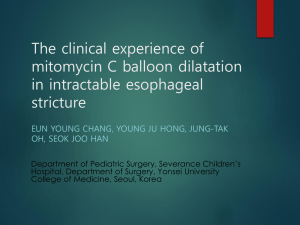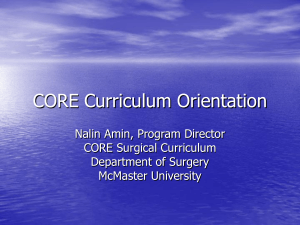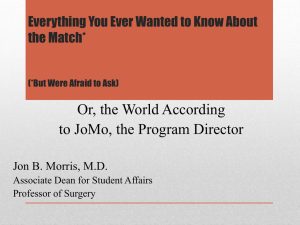Laryngectomy
advertisement
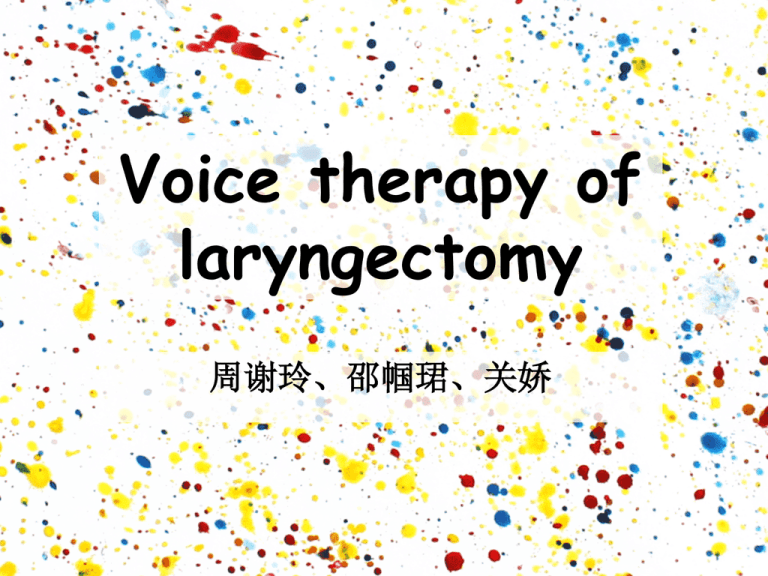
Voice therapy of laryngectomy 周谢玲、邵帼珺、关娇 Topics • Laryngectomy * when * how * acoustics characters • Voice theropy * different means • Comparation Laryngectomy Laryngectomy——when We alredy know that: * Larynx is an important organ * Latyngectomy is traumatic So: *Laryngeal cancer (type &location & extent) *life threatening condition * “Salvage” surgery after failure of nonsurgical treatment Such as: radiation chemotherapy …… Laryngectomy——when * 声带癌已浸及前连合或同侧声带后 1/3处,使声带运动受限或已累及对 侧声带。 * 声带以外部位如假声带、会厌、杓 会厌皱襞及环后等处癌肿。 * 声门下区癌肿。 * 喉部其他恶性肿瘤,如肉瘤等 Laryngectomy——how 1.Laryngeal cancer * Incidence rate: 1~2%of all cancer; 20% of head and neck cancer; the ratio of male to female is 13 to 1 * predisposing factor: cigarette smoke, alcohol, and noxious fumes * Locations: the supraglottis, the subglottis, and the glottis Laryngectomy——how 2.Two kind of larygectomy * Total laryngectomy The larynx, containing the vocal * Hemilaryngectomy ( partial folds, has been removed, usually laryngectomy ) at the level of the first The extent tracheal ring and location of the tumor will diratate the extent of the surgery Laryngectomy——how Tumor location Kind of laryngectomy Crosses the midline Total laryngectomy Only on one side of the larynx Hemilaryngectomy and other partial laryngectomy Laryngectomy——how 图1 切口 图3 分离舌骨周围诸肌 图2 剪断舌骨中段 图4 暴露甲状软骨翼板,切断其上角 Laryngectomy——how 图5 分离切断 甲状腺峡部 图7 于环状软 骨下缘切断气管 图6 缝扎甲 状腺峡部 图8 将喉体向上翻起, 与食管前壁分离 Laryngectomy——how 图9 自杓状软骨后 缘进入喉咽腔 图10 沿杓状会厌皱襞,分离、剪 开会厌舌面粘膜,由下而上剥离喉体 图11 分离会厌前 间隙,暴露会厌 Laryngectomy——how 图12 剪开会厌边缘粘 膜,自上而下截除喉 体 图13 自两侧外上方 缝合喉咽粘膜 图14 “y”形缝 合喉咽粘膜 Laryngectomy——acoustics 1. partial laryngectomy Because of the tumor excise (a tissue deficit ),there will be some changs: *stiffness due to scarring *a gap in the glottal area when the folds are approximated Laryngectomy——acoustics * air wastage → a breathy voice & short phonation time * Inadequate medial compression → reduced loudness level * Unequal mass between the right and left VF , an irregular vocal fold vibration an attempt to compensate for the excessive glottal gap by hyperactivity of false VF → a rough voice Laryngectomy——acoustics 2. Total laryngectomy Laryngectomy——acoustics the trachea attached to the neck, sounds the patient he can make only certain voiceless that RPRAP mode doesproduced not breathe throughcheek, his nose are by tougue, andor lipmouth, The of voice the airlose column diverted away the compressed of is the air filling hisfrom mouth or resonators aand throat.not realartculators whisper Voice therapy Voice therapy The importance of speech: * If you lose your voice, you can’t argue with your wife; you don’t have to bother with telephone pests; and you’ll never talk yourself out of a job or into trouble * Speech is the primary means whereby social relationships are achieved and maintained ,and its loss seriously threatens a person’s sense of security, adequacy ,and acceptance. Voice therapy Preoperative care * Partial laryngectomy * * Total laryngectomy Voice therapy——Preoperative * An explanation of operation, an curable cancer * Discussion of postoperative feelings * Preparation for loss of speech * Discussion of normal production of speech To give the patient some insight into what is going to happen Voice therapy——partial * inhalation phonation using the vowel /i/ to eliminate the excessive vocal effort and reduce the false VF activity * Use an upward pitch to increase VF tension and gain better approximation Voice therapy——total * Begins with a review of the mechanics of speech production as it occurs when the larynx is present * Tell the patient that much of his speech apparatus has not been altered and the operation did not affect many of his speech habits and skills Voice therapy——total Three general communication options: * Artificial larynx (AL) * Esophageal speech (ES) *Tracheoesophageal puncture and prosthesis (TE) 实质:Learn to substitute other structure for his missing ones Voice therapy——total Adoption rate of the treatment: Esophageal Speech---------------------6% Artificial larynx-electrolarynx-------55% Tracheoesophageal Prosthesis--------31% Remained nonvocal----------------------8% ——By Hillman and colleagues Esophageal Speech---------------------42% Both adopt ES and EL------------------91% ——By Janpanese Voice therapy——The artificial larynx * Types: Mechanical type : a metal cylinder containing a reed, lead the sound to the mouth by means of a tube Electric type : a mechanical box similar to a flashlight (The neck type; The intraoral type) * Theory: Introduces sound for speech by placing the instrument against the external throat or oral Neck type: you place it aagainst throat, structures or inserting tube oryour fitted intraoral type: vibration sound is prosthetic electrolarynx into the mouth while push a buttom, and the machine transmits a transmitted directly into your mouth via a speaking. noise to your throat which you then vibration small tube, words and sounds are made in a form into words and sounds with your lips, similar manner teeth, and tougn Voice therapy——The artificial larynx * Station: Frequently encouraged during the first few days following surgery ; A good alternate mode (other mode fail ,environmental factor) * Voice quality: A monotonic and robotic sounding (no pitch adjustment options) Voice therapy——The artificial larynx The steps in speech therapy: * find the “sweet spot” * Learn to hold and operate the EL in your non-dominant hand since it frees up your other hand so that you can write Voice therapy——Esophageal Speech * Theory: Compressing air within the oropharynx and injecting this denser air into the more rarefied space of the esophagus Bring compressed air into the esophagus ;once the air is in it ,external forces compress the air within it and expel it, the esophageal explosion sets up a vibration of the pharyngoesophageal (PE) segment * types: Injection and inhalation Voice therapy——Esophageal Speech * Station: a traditional therapy method * Voice quality: hoarse , low-pitched , and often belchlike quality Plosive consonants(/p/, /b/, /d/, /t/, /k/, /g/) Affricatives containing plosives(/t∫/, /dЗ/ Voice therapy——Esophageal Speech The steps in speech therapy: * Learn to swallow air into the upper part of the esophagus and immediately force it back (as it passes the narrow throat muscles, it is made to pulsate, and a belchlike sound, similar to that of a vowel, is produced) * Imitate the movements voluntarily (drinking cokes or any carbonated beverage) * Learn to produce vowels, consonants, and syllables * Stresses the development of vocal inflection * Speech restoration Voice therapy——Esophageal Speech * The esophagus functions as a substitute for the vocal fold * The removal of the larynx increase the space in the neck available to the esophagus and permits it to expand to accommodate the air necessary for speech * Control the air at the upper opening of the esophagus * Learn to inhibit breathing while speaking Levels of esophageal speech * No esophageal sound production—no speech * Involuntary esophageal sound production—no speech * Voluntary sound production part of the time—no speech * Voluntary sound production most of the time—vowels differentiated, monosyllabic speech * Esophageal sound produced at will—single word speech * Esophageal sound produced at will with continuity—word grouping * automatic esophageal speech Voice therapy——Tracheoesophageal • Theory: makes a small puncture in the wall between the trachea and esophagus Tracheoesophageal continued How to do the surgery ①makes a small hole in the rear of the stoma leading to the esophagus ②Once this puncture heals ,a prosthesis is fitted and inserted into the opening Tracheoesophageal continued How to speak after the surgery: occlude the stoma with your thumb or finger and simply force air through the prosthesis into the esophagus This air movement vibrates the walls of the esophagus and you can create sounds and words normally with your lips ,teeth ,and tongue ,etc Tracheoesophageal continued • easy to have leak Cleaning and flushing Installed prosthesis Voice therapy——Esophageal Speech Keep in mind: Avoid any early attempts at speech (speech therapy should not be started until the muscles and mucous membranes are well healed and no longer tender) Esophageal speech Comparation Electrolarynx (EL) Tracheoesophage al Puncture (TEP) needs to train no much needs to train does not need to train both hands to be possible to move freely, and can work while speaking both hands not to be possible to move freely, cannot work while speaking single-handed to be possible to move freely, only can work with single-handed when speaking can speak in everywhere need mechanism can speak in everywhere spoken language is clarity and good spoken language is not clarity and good Spoken language is clarity and good sound not loud sound loud sound loud easy weary not weary not weary not to inhale in wrong way not to inhale in wrong way easy to inhale in wrong way Research in voice therapy in China • Non-surgery method • Surgery method Non-surgery Method • Instrument method Disposition artificial larynx Electrolarynx • Non-instrument method Esophageal speech Surgery Method • Syrinx Speech • Larynx reproduce technology • Larynx transplant technique Thank you!
